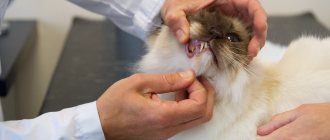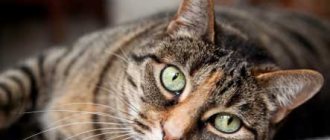Alena Igorevna Goncharenko
veterinarian Petstory
Skin diseases in cats are very common in veterinary practice. Such patients account for at least 30% of all types of visits to the clinic for help. To describe the condition of a pet's skin, owners usually use popular terms such as “sores,” “scabs,” “wounds,” and “ulcers.” In this article we will use the same terms for a better understanding and try to figure out why such problems arise and how to deal with them.
Acne
Acne can appear due to improper care of your pet, severe stress and emotional distress. Acne can develop into pustules and ulcers, which cause severe pain for your pet and sometimes lead to inflammation.
A complication of acne is folliculitis. It is a swelling around the hair, usually with liquid contents. When touched, the pet experiences pain.
Self-medication and squeezing pimples are not recommended. You can treat rashes with tar soap or shampoo.
Causes
Skin pathologies can bother cats temporarily, for example, arising when changing food and spontaneously stopping when returning to a normal diet. But much more often, pets are worried about seasonal diseases associated with increased activity of skin parasites. The most common causes of skin diseases are:
- ectoparasites - fleas, ticks lead to the occurrence of dermatitis, sarcoptic mange, notoedrosis, otodectosis;
- fungal infections cause lichen;
- improper care can cause an allergic reaction, acne, eczema;
- abnormalities in the development of sebaceous glands and hair follicles also cause acne;
- allergies, stress, injuries, kidney diseases, tumors, diabetes mellitus lead to bacterial infections of the skin;
- psychological disorders can cause baldness (alopecia);
- diseases of the internal organs (stomach, liver, kidneys) provoke eczema.
Fungal otitis media
The disease is an inflammation of the external auditory canal. The development of fungal otitis occurs due to a weakened immune system. The pet shakes its head and scratches its ear.
The ears turn red quickly and strongly. When examining the ear with an otoscope, severe inflammation of the skin and many fungal deposits are observed.
Every day you need to clean the ear of accumulated secretions with napkins and cotton swabs. Afterwards you need to treat them with alcohol-based antiseptics.
Dermatomycoses
Dermatomycoses are infectious zooanthroponotic diseases with characteristic lesions of the skin and its derivatives, caused by pathogenic dermatophyte fungi.
Among animals, the most common are: trichophytosis, microsporia, scab.
Microsporia and trichophytosis are combined under one common name “ringworm”.
Symptoms:
- With microsporia - the appearance of limited spots of peeling and the formation of crusts on the skin of the paws, muzzle, and torso. The hair in the affected areas is sparse and breaks off easily. Lesions can be focal or disseminated.
- In cases of trichophytosis, sharply limited foci with broken hair and a flaky scaly surface or areas of inflamed skin and its follicles form on the skin in the area of the head, neck, torso, base of the tail and limbs.
Treatment:
1. When choosing medications, special increased skin sensitivity should be taken into account, and therefore it is necessary to give preference to products that have minimal irritating and cauterizing effects: Vaganova ointment (Lysol - 30.0; birch tar - 50.0; sulfur color and ASD, fraction 3—100.0 each; petroleum jelly—800.0), SK-9—chlorinated turpentine (200–500 ml per 10 liters of water), ROSC preparation, trichocetine (in the form of 2% liniment), phenothiazine (5% fish oil solution).
2. For disseminated lesions, the use of the antibiotic griseofulvin is indicated. It is prescribed orally at a dose of 2 mg per 1 kg of animal weight for 8-15 days.
============================================================================================================================================================================================
Ear mites
Ear mites appear as a result of improper care. Symptoms: scratching, foul odor from the ears, dark gray discharge, redness of the skin of the ears, fever.
Treatment can begin after visiting a veterinarian. Various aerosols (based on Dermatosol or Tsiodrin), drops (Bars, Tsipam, Amitrazine) and ointments (Nicochloran, Phenothiazine) are used. Dark discharge should be removed with a soft cotton cloth or cotton wool.
Cheyletiosis
“Wandering dandruff” or cheyletiosis is caused by mites of the genus Cheyletiella. Animals develop dandruff along the spine line.
Symptoms:
- Severe itching.
- Minor hair loss, flakes, dandruff.
Treatment:
1. Injectable drugs: Pyrethrin, Fipronil.
2. Additionally, animal hair is treated with antiseborrheic shampoos. Long-haired cats need to have their fur trimmed first.
============================================================================================================================================================================================
Psychogenic alopecia
Due to thorough and prolonged licking, cats may develop bald spots. This behavior means that the pet is stressed. Sometimes baldness occurs due to allergies and fungal diseases.
First you need to check your pet for parasites and make sure there is no hypersensitivity to external irritants.
Prevention
The main methods of preventing skin diseases in cats include regular antiparasitic treatments. Using drops on the withers, even for domestic cats, allows you to avoid many unpleasant situations associated with infestation with fleas and ticks. The contact of a domestic cat with stray animals should be limited. It is necessary to organize the pet’s living environment in such a way that it does not need anything and does not experience chronic stress. Stress can lead not only to psychogenic itching, but also to a decrease in the overall immunity of the body.
Lice and fleas
Lice and fleas are small insects that feed on blood and the top layer of skin. If the case is advanced, it is impossible not to notice them on the pet. Favorite localization is around the tail and head.
At an early stage, an accumulation of a black substance, a waste product of fleas, is noticeable. Also, the pet experiences itching, hair loss, redness of the skin, and the formation of wounds.
Lice are eliminated using a special shampoo. Fleas are removed by treating things with which the pet comes into contact with anti-flea agents, carriers, bedding, and all carpets in the house.
Treatment of skin diseases in cats
If bacterial or fungal flora is detected in the affected areas of the body, local and systemic drugs, various antibiotics and antifungal agents are prescribed. If the cat is good at washing, bathing with antibacterial shampoos is convenient. Skin mites are treated with antiparasitic drugs. Recently, modern preparations in the form of drops on the withers have been used for this; they are highly effective. Autoimmune diseases are treated with drugs that suppress the immune system - immunosuppressants. Such drugs can be prescribed either as a course or on an ongoing basis. To treat allergies, it is necessary to identify the allergen and eliminate it from the animal’s life. But this is not always possible. Otherwise, drugs against itching and inflammation are used. If your pet's allergies are seasonal, then the tablets should be taken only during the period of exacerbation. If the allergy is constant year-round, then the drugs will have to be used for life, trying to choose the minimum effective dosage. To treat psychogenic itching, sedatives and antidepressants are used.
Allergies
Allergies are usually caused by parasites. Symptoms: baldness in certain areas, itching, spots of different colors. The allergy will go away after eliminating the fleas after 5-6 weeks.
Also, allergies can be due to external irritants and food. Treatment in this case becomes more complicated because identifying the allergen is not easy. Shampoos with hydrocortisone work well as local antiallergic agents.
They give an immediate but short-term effect. Hydrocortisone ointments are used when pets have itching. They are applied to small areas that are inaccessible for licking.
Atopic dermatitis
One of the types of allergies that is caused by irritating external factors: pollen, dust, synthetic detergents.
Symptoms:
- Baldness.
-Pustules on the skin.
- Itching.
Treatment:
1. The doctor can prescribe broad-spectrum antimicrobial drugs in combination with antihistamines (Chlorpheniramine, Clemastil).
2. Non-steroidal anti-inflammatory drugs are prescribed.
3. If the animal’s condition is alarming, immunosuppressants are prescribed to suppress the “independent activity” of the immune system. Cyclosporine has proven itself well.
============================================================================================================================================================================================
Tail gland hyperplasia
If the tail gland has increased hyperplasia, excessive accumulation of sebaceous secretion appears. It is released and envelops the hair at the point of growth, blocking its further development. Because of this, her hair falls out and areas of baldness appear.
Therapy involves monitoring the problem area. Castration can help cats.
Recommendations for nutrition during the recovery period
Cat nutrition during a difficult period of recovery and rehabilitation should have an integrated approach. It must be remembered that a cat is a predator by origin.
Complete dry and wet food should correspond to the natural needs of the cat, its characteristics and history, take into account its dermatological problems and laboratory tests, depending on the specific case. The diet should be high in protein and contain polyunsaturated fatty acids omega-3 and omega-6, found in fish, which enhance the protective functions of the skin and accelerate healing.
The special needs of pets with skin and coat problems are taken into account in Purina® PRO PLAN® NUTRISAVOUR® Derma Plus complete wet food and PRO PLAN® Elegant Adult dry complete food for adult cats. The diets support healthy skin and a beautiful coat thanks to the content of high-quality protein, vitamin E and omega-6 fatty acids, zinc. In addition, they reduce excessive hair loss, support healthy digestion by controlling the formation of hairballs, and help hair move smoothly through the digestive tract.
During the recovery period, the cat needs special care and attention. It is important to maintain the indoor microclimate, sufficient air humidity and lighting, the cat’s activity and its psychological state.
Getting rid of dermatological problems should be approached comprehensively from different angles, and then the result will not keep you waiting!
Demodicosis
Demodicosis is an extremely dangerous disease for a pet. It can lead to the death of a cat instantly, sometimes the owner does not even have time to start treating it. Demodicosis appears due to the bite of ticks, which are numerous in the warm season.
Cats cannot take preventive and protective measures themselves, so they often become their victims. Symptoms: damage to large areas of skin, itching, redness. The worst thing is that if a pet gets sick once, then it becomes a constant source of infection. His offspring will also suffer from demodicosis.
It is important to take preventive measures - treat the skin with products that kill ticks (Bars, Harts). It is also worth using anti-inflammatory drugs (Dexafort, Laurabolin 50) and anti-itch drugs (Stop-itch).
Congenital diseases
The most common congenital skin disease is albinism. This is the absence of any pigments in the fur, skin, eyes.
These cats look the same:
- white wool, sometimes thin and untidy;
- white paw pads, nose, skin under the fur;
- white vibrissae;
- pinkish ears;
- red or pink eyes that glow dull red in the dark.
Albinos do not tolerate bright sunlight well and easily get sunburned, including on areas covered with fur. There is no cure for albinism.
More serious congenital diseases are dysplasia and lack of skin. In the first case, the formation of the hair follicle is disrupted. The fur becomes coarse or curls. This mutation served as the basis for some cat breeds. The congenital absence of skin or a significant area of skin in kittens is fatal.
Eczema
Eczema is an unpredictable disease.
Appears due to many factors, including:
- Severe skin contamination with parasites, dirt, bacteria;
- Improper wearing of collars and synthetic clothing for cats;
- Complication of any disease (pathology of the nervous system, kidney disease, stomach and liver).
The main symptom is a weeping surface of the skin. Scratching causes knots and redness to form. The cat is rapidly losing weight, has a fever and kidney problems.
For diagnostic purposes, the veterinarian will take a skin scraping to rule out the possibility of other diseases. Afterwards he should prescribe antihistamines. You should not try to treat your cat without a doctor, as complications may develop.
Carrying out diagnostics
It is impossible to find out for yourself what kind of black marks appeared on the body of a pet. Even with some experience and knowledge, the patient’s owner will not be able to make an accurate diagnosis. To determine the nature of the skin rash, you must consult a veterinarian.
The doctor will examine the patient and find out details about the animal’s nutrition. Information about the last vaccination and deworming performed will be important for making a diagnosis. For an accurate clinical picture, diagnostic procedures can be performed:
- Scraping from the diseased area to determine the pathogenic microorganism.
- Blood sampling for serological analysis aimed at excluding other similar diseases.
- Bacteriological culture to determine the type of pathogen.
- A biopsy prescribed to identify benign or malignant neoplasms.
As a result, the veterinarian will have all the data to make an accurate diagnosis and develop a treatment regimen. The therapy prescribed by the doctor will be aimed at symptomatic elimination of skin manifestations and relief of negative consequences.
Bedsores
The disease is often observed in cats in old age or after suffering an injury. Bedsores are areas on the skin that rot and die over time. If the pet is in a lying position for a long time, the disease may manifest itself.
Symptoms: pain when touched, decreased temperature of the dying area, ulcers, color change. It is worth taking preventive measures - periodically turning the cat over after operations, prohibiting sitting on the damaged paw for a long time. Therapy consists of treating wounds, dressings, and removing dead tissue.
Each disease can progress, which leads to the process of virus reproduction. Because of this, the pet suffers, he has problems with sleep and appetite, he becomes less sociable and cheerful.
If your cat develops irritation in the area of its face or body, you should take it to a specialist immediately. Not all cat diseases are not contagious to humans.
Some viruses and fungi can adapt to the organism that is nearby. It is highly likely that if the pet is left untreated, the owner’s immune system may weaken and spots may appear on the body.
Can a person get infected from a cat?
Most skin diseases in cats are not transmissible to humans and are only contagious between felines. Ringworm is potentially contagious to humans, and children, the elderly and people with weakened immune systems are considered especially vulnerable. Adults most often do not become infected from cats. If you notice signs of lichen, you should immediately consult a dermatologist. Notoedrosis can cause pseudoscabies in humans, but the disease itself does not require treatment.











